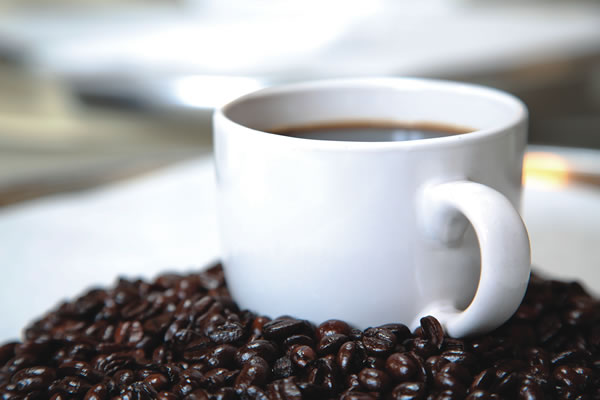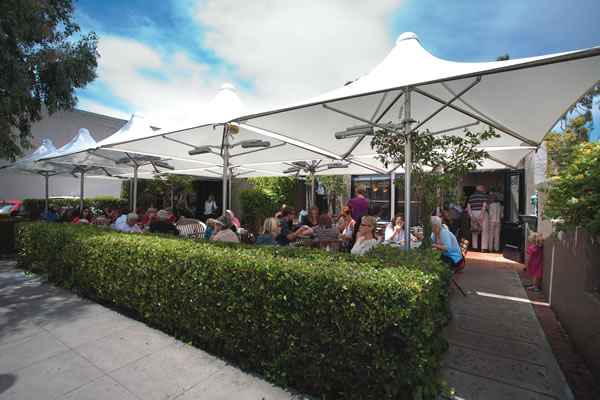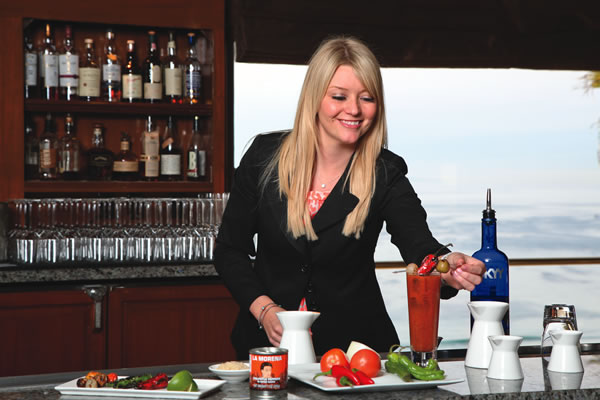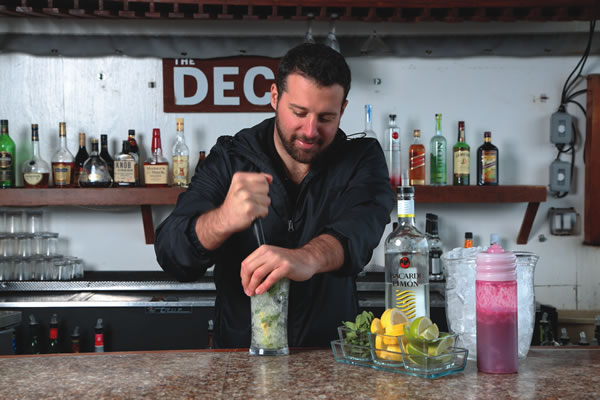Laguna’s bartenders and baristas share secrets for creating your favorite beverages.
By Somer Flaherty and LBM Staff | Photos by Jody Tiongco
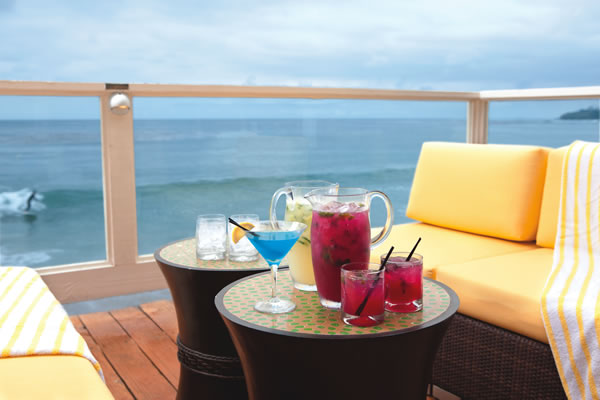
Watching the sun dip behind the Pacific Ocean as locals and visitors sip espresso or cocktails on a restaurant patio, the town resembles those of the Amalfi Coast or French Riviera—where it’s a cultural norm to break from the daily grind and take time to enjoy a drink.
Coffee and cocktails, whether alone or with friends, are part of the local culture. It’s both a way to relax and retreat, as well as socialize. (And if you take a European approach—everything in moderation—you can feel good about imbibing too!) As such, we’re spoiled with a bevy of fine beverages, from that morning cup of joe to the happy hour mojito. But what makes the coffee at Zinc Cafe so palatable, or a cocktail at The Deck more refreshing than most? We bellied up to some of our local bars to ask the masters behind them what their tricks are to creating our favorite area classics.
Not Your Average Cup of Joe
Coffee aficionados will agree: “The beans matter,” says Alyssa Mendez, assistant manager at Ocean Avenue’s Zinc Cafe. Fair trade, locally roasted, single origin or hand-blended—coffee beans have sustained economies, built corporate empires and can be a luxury, known to top $1,100 for a kilogram of beans—about $31.18 per ounce (the price for Black Ivory coffee that is brewed from beans which have been hand-picked out of elephant dung) and available only at select five-star hotels throughout the Maldives, Thailand and the United Arab Emirates.
The secret to Zinc’s coffee, Alyssa says, is beans from Intelligentsia, a company started by two former San Francisco coffee roaster-retailers that was called “the gold standard” by The New York Times Magazine. Intellegentsia has a buying team that cumulatively spends each and every day of the year at the coffee bean source, developing coffee alongside its team of growers—and all beans are exclusive to the company opposed to being sold in the open market. “We’ve been using them for a few months now and [have had] a ton of compliments,” Alyssa says. “I’m a big coffee drinker, and these beans have a bold flavor that really comes out a lot more.”
At the other end of Ocean Avenue, Anastasia Cafe is known for its all-day breakfast and delicious coffee—a variety that owner Ami Garavi says is made from a special blend of beans only available at his cafe. Equally important to the quality of the beans is their age, Ami explains. “We hand-choose the beans, and get our shipment each week so they are very fresh,” he says. “Beans that are older lose their aroma.
“Because of our quality of beans and how often we get them, each cup is very strong and always smooth and joyful,” he says.
Just as important as the beans is what you do with them. Making coffee (and espresso) is more than just flicking a switch and having a machine pour or push water through the grinds. The most savory of sips are achieved by using the best techniques.
The key to a great espresso is timing, says Andrew Moeller, manager at The Koffee Klatch on Coast Highway. “If I’m making a latte, I’ll steam the milk first and as soon as it’s halfway to reaching its perfect temperature I’ll start the espresso shot,” he says. “As soon as that espresso shot is done, the milk is done. This really keeps the milk fresher and creates a much better taste when you pour it in the espresso. Some baristas start the espresso at the same time they start steaming the milk, and it just sits there. I’ve learned that just makes a stale drink. Timing is everything.”
To properly steam the milk, it’s important to position the steam wand right below the surface of the milk and then swirl the wand in a circular motion. Then drop the wand lower until the milk reaches just the right temperature on the thermometer (for Andrew, this is between 130 and 140 degrees). “Anything above that, [and] you’re going to burn the milk,” Andrew says. “Anything below that, and you might as well get iced coffee.” The perfect temperature ensures that the sugars in the milk will become sweeter but not burned. To recreate this at home, you’ll need your own milk steamer, Andrew says. “Don’t use stove-top warming methods; it’s just not going to give you that same taste as you get at your coffee shop.”
Another main component to enjoying that cup of coffee is impossible to duplicate at home—the atmosphere, he adds. “Where you are drinking your coffee also plays a huge part in how you experience your coffee. We have a very homey feel, and it’s not like the corporate office. We like our customers to feel like they can hang out as long as they want.” This means not only more great coffee just a few steps away, but cozy lounge areas, study tables and accessible, free wireless Internet.
The Un-virgin Mary
The bloody mary has been called a liquid salad. A drink that thoroughly indulges the farm-to-table ethos, the bloody mary is now as popular as ever. Packed with vitamins and a bit of vice, the key to creating a tasty version of this elixir is a good mix, a kick of spice and some great toppings, says Erin Snider, food and beverage manager at The Ritz-Carlton, Laguna Niguel.
The cocktail is near celebrating its 80th birthday, when its alleged creator Fernand Petiot made the tomato-based drink in New York (which now celebrates Bloody Mary Day each year on Oct. 5). In the nearly eight decades since its incarnation, the drink has been recreated with everything from pickled beets to Brussels sprouts to horseradish vodka. At the Ritz-Carlton, the secret starts with the mix. “We make our own bloody mary mix in-house fresh every day,” Erin says. “And since our food at Raya has some Latin inspiration, we also add chipotle to our mix—that’s our secret ingredient.” If an artisanal approach isn’t possible at home, she says store-bought mix can be used as a starter for the bloody mary mix. “You can [then] add special ingredients to make it your own. Some people may be scared to make the whole recipe from scratch, but it is really easy and my favorite way to have a bloody mary.”
Use your favorite tomato juice and vegetable juice and mix together, to start. From there, add horseradish, Worcestershire, Tabasco, fresh lemon juice, celery salt and black pepper. (Erin also uses a little bit of chipotle for an additional Latin-inspired kick.) Pour the mixture over ice and add toppings—celery, onion, olive, lemon and lime. “The result is a drink that bridges the vegetable garden with your liquor cabinet,” Erin says.
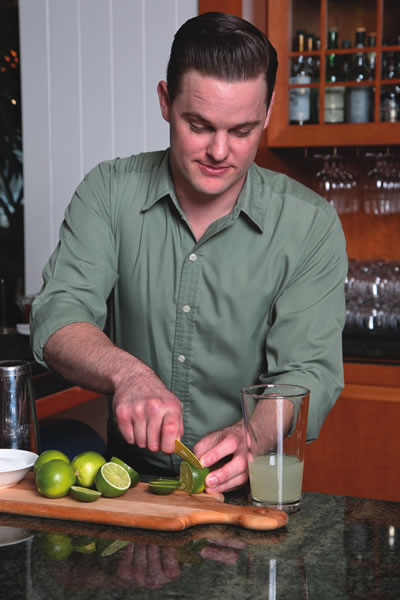 Fruitful Classic
Fruitful Classic
The daiquiri may be the ultimate vacation drink, but that doesn’t mean you can’t indulge while at home. The cocktail has come a long way from its paper umbrella garnished roots, and at Montage Laguna Beach’s The Loft restaurant, bartender Nic Hirsch says the daiquiri is a misconceived cocktail. “When you mention a daiquiri, it paints a picture of a foofy, fruity drink, but the classic daiquiris are what I enjoy making,” he says. “They’re so simple, but can be made diverse just by going from one rum to the next.”
Nic says the key to making a great daiquiri is finding the delicate balance between the triptych of ingredients: rum, lime juice and sugar. “I live by the principal of always incorporating pure ingredients, such as fresh squeezed limes,” he says. Even as a last resort, he won’t use store-bought mix. “Plenty of places get away with it, but I believe there’s no substitute for fresh juice right out of the fruit.”
For a drink with such few ingredients, an important part of creating just the right flavor is measuring your ratios. “Rum, sugar and lime are all powerful flavors on their own, so to let them be in harmony together it’s important to be mindful of their ratio,” Nic explains. “One ingredient is no more important than the next.” He uses 2 ounces of rum, ¾ an ounce of fresh lime juice and ¾ an ounce of simple syrup (a 1:1 ratio of sugar to water, Nic says).
A daiquiri should always be served shaken and strained. “The blender was actually invented nearly half a century after the daiquiri,” Nic shares. “Therefore, the daiquiri was never intended to be a blended drink.”
Something in the Muddle
 The mojito originated as the farmers’ drink in Cuba during the late 19th century, and has since gained such mass appeal that liquor companies have unveiled mojito-flavored liquors—no additional ingredients needed. However, the most important part of creating a true mojito is the marrying of fresh ingredients with the muddling technique, says Nick Papadatos, bar manager at The Deck. Nick estimates the establishment serves up to 200 mojitos a day during the busy summer season.
The mojito originated as the farmers’ drink in Cuba during the late 19th century, and has since gained such mass appeal that liquor companies have unveiled mojito-flavored liquors—no additional ingredients needed. However, the most important part of creating a true mojito is the marrying of fresh ingredients with the muddling technique, says Nick Papadatos, bar manager at The Deck. Nick estimates the establishment serves up to 200 mojitos a day during the busy summer season.
“Muddle a little ice, three or four fresh lime slices, simple syrup and eight to 10 fresh mint leaves,” he says. “Make sure to break up the ice into the other ingredients.” The Deck has jazzed up the classic mojito with its own version: The Laguna Mojito features a prickly pear fruit, also known as dragon fruit. “The fruit gives the [mojito] a unique flavor and a great pink color,” Nick says.
To recreate the mojito at home, Nick says fresh homegrown mint is a good option (The Deck gets its delivered each day from a specialty producer), plus a few limes, real cane sugar and a high quality rum—because the caliber of a great cocktail is directly related to the quality of the alcohol used—is all that’s needed. Already made mixes, Nick says, “take the fun out of bartending!
“It’s much more rewarding (and delicious) when it’s made from scratch.” LBM


